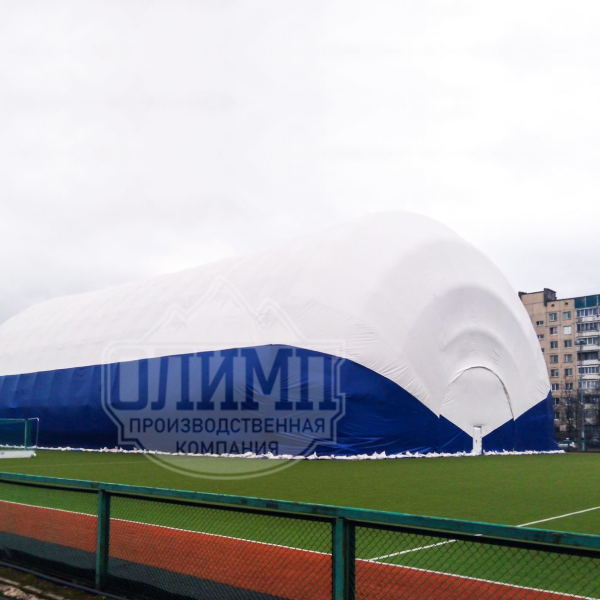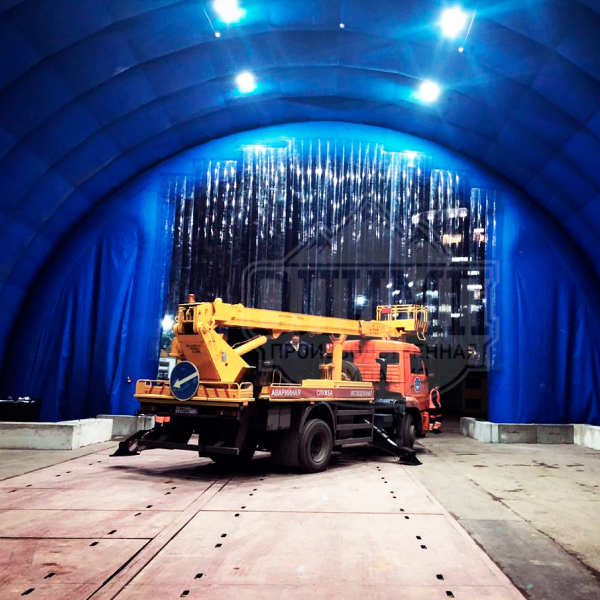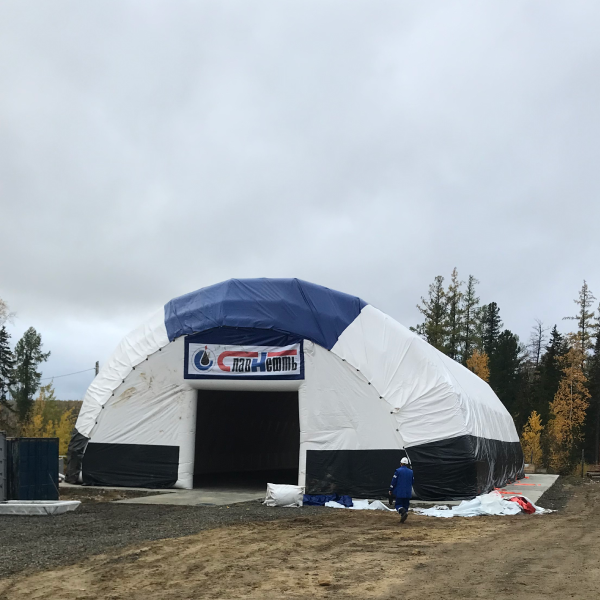
PNEUMOHANGARS AND STORAGE
Features

Usable area
from 100 to 10 000 m²

Weight of the pneumohangar
from 1.8 to 100 tons

Inner width
from 10 to 40 m

Operating temperature
from – 50 to +60 °C

Lifetime
10-15 years on average

Setup time
from 1 to 7 days

Inner height
from 5.5 to 20 m

Windproof
to 45 m/s

Material
reinforced PVC

Guarantee
3 years

Inner length
Not limited

Snowproof
to 25 kg/m²
Benefits

Taking care of the staff
Ventilation, heating and air conditioning systems, which we can complete our pneumohangars are indispensable for storage of products, materials, equipment or cargo sensitive to temperature, dust and sunlight, rain and hail and other, including extreme, weather conditions

Work in all climatic zones
Our plant products are able to help solve specific problems that arise in mining, oil and gas, construction, aviation and military industries, located in the most remote areas of our homeland. Work in extreme environmental conditions, maintaining a given temperature, airtight construction – indispensable qualities of the shelter when the elements are not your ally

Comfortable working conditions
Warehouses and hangars are not just for intangible production assets. A full range of amenities such as independent heating, ventilation and air conditioning systems create a comfortable working environment for employees. Being in the comfort of the staff maintains the quality and speed of work at a high level
Looking for business
a fast building?
Construction of a pneumohangar
- Airframe inflatable structure (AFS) – a structure consisting of interconnected pneumoballons (arches), which are the inflatable frame, front and rear end walls and a shelter top tent.
- The advantage of this simple design is that the usable area is essentially regulated by the number of arches. Air is pumped into the air cylinders and then the required pressure level is maintained by the automatic air inflation system (AAPS).
- The front and rear end walls are equipped with door units, pneumatic gates, openings for supply and exhaust ventilation and insulated ducts for the chimney.
- Inside the structure is lighting, electrical, based on the purpose of the building is set for the entrance to the people and/or cargo gates for machinery.
Airframe structures (AFS) first appeared in the middle of the XX century.
The idea for a building with no struts or supports came from the world of balloons and airships. The first air-supported structures were the DEW (long-range early warning) line domes used to protect radar equipment in the harsh Alaskan climate.
These were air-supported buildings (ASB). The stability of the framework of such structures was maintained by generators and systems of continuous maintenance of excess atmospheric pressure. The essential disadvantage of such structures was essentially one – the fuel used to maintain the dome burned out instantly.
At the end of the XX century with the development of technology it became possible to mass-produce inflatable airframe structures of large spans. This is a more advanced technology compared to air-supported structures, which does not require constant pumping of air, and hence overconsumption of energy (fuel or electricity).
Our company has extensive experience in the manufacture and operation of large-span airframe structures – pneumoangars. To date, more than 200 projects with a total area of over 150,000 square meters have been implemented.
Pneumohangars were in demand primarily for the development of new territories, because of its mobility, erection speed and resistance to harsh conditions. The main advantage over other quickly erected structures (e.g., metal frame structures) is the rapid assembly and disassembly of pneumatic construction. It is not necessary to have a special foundation, a relatively flat surface is enough to deploy a pneumoangar on the ground.
Mobility due to compactness and ease of transportation, the minimum number of approvals from regulatory agencies and an affordable price tag made AFS attractive for solving the mass of commercial and industrial problems.
Pneumoangars developed by the factory «Olymp» are suitable for a wide range of tasks. Our pneumatic structures are suitable for use in any climatic zone, including in the Far North. The materials from which we manufacture our products withstand temperature fluctuations from -50 to +60 °C. Our experts calculate the wind and snow loads for each climatic zone, which eliminates mechanical damage to the surface and ensures a long service life. Based on the objectives and wishes of customers we additionally install a heating system to maintain a comfortable microclimate inside the entire space of the hangar.
The main material in the manufacture of pneumoangars is a reinforced five-layer PVC fabric. It meets the requirements of fire safety, is resistant to ultraviolet light and is a reliable protection against other adverse environmental conditions. PVC flaps are connected to each other by means of hot air welding technology seams. With this method of connection, the bleed strength of the welded joints is at least 1.2 kN in the longitudinal direction and 1.1 kN in the transverse direction. This means that a tear is more likely to occur in a single piece of PVC than at the point of connection. But don’t worry, under normal conditions PVC fabric will never break.
It takes an average of two months from the development of the layout to the erection of a pneumatic frame structure at the customer’s site. The area and shape of the object is essentially unlimited. We produce any type of pneumohangars, any shape (from classic rectangular to freestanding rooms with independent of each other vestibules or transitions), any size (from 100 to 10000 m²), focusing on your needs.
The methods of fixing the AFS on the ground are as follows:
Anchoring method
If you choose this method of securing the AFS, you will need a concrete base. The anchor is installed in a hole specially made for it, then the arch or end wall is attached to it. Airframe dome with this method of attachment can be erected over already completed structures (swimming pools, sports fields, etc.).
The pile method
This method is relevant if there is no concrete base on the ground. A level ground is enough for pile anchoring. Holes are prepared in the soil with a drilling machine, special blanks (piles) are inserted into them, and then the fastening is done by the anchoring method. Anchors are screwed into the piles, and the elements of the structure are attached to the anchors.
The ballast method
Bags of sand are placed inside the arches, which are essentially ballast. Ballast is installed through specialized sealed zipper locks, which are pre-welded into the elements of the structure. This ensures the stability of the structure.
Tests have shown that the anchoring method is suitable for use in places where wind speed does not exceed 20-25 m/sec. The ballast method, on the other hand, ensures the stability of pneumohangars at wind speeds of 47-53 m/s.
But with all the convenience of this method of fastening PCC (cases where the customer does not have the opportunity to use the concrete base, not uncommon), there is one significant disadvantage. It is not possible to create a complete seal at the zipper locks, so more air and therefore energy is required to maintain the necessary pressure when choosing the ballasted method of attachment.
Pneumohangars, installed on a flat surface without the use of foundations, piles or other method of attachment to the ground, are classified as a temporary type of building. No special permits are required for their installation. Mobile inflatable structures are included in the category of movable property, which means that the owner of such a prefabricated and mobile structure is not subject to property tax. Do not forget that the price of prefabricated hangar is several times lower than that of permanent structures.

Benefits
- Cost. Pneumatic-frame structures, other things being equal, will cost less than metal-frame or capital structures.
- Exploitation. Do not require special operating conditions if the instructions are followed.
- Production time. A 1,000 m² hangar takes about two to three weeks to produce.
- Transportation. Low weight and dimensions make it easy to transport over long distances.
- Mounting. A crew of a dozen workers will assemble a 1,000 m² hangar in 3 to 5 days.
- Documentation. Do not require a lot of approvals and piles of permits.
- Reliability. Designed for use in harsh environments.
- Mobility. Mounted and dismantled no more difficult than a Lego constructor.
- Installation over equipment. Erection on top of pools, courts, equipment.
- Longevity. The average life span is 15-20 years.
- Versatility. Reaming is possible on any flat, hard surface.
- Custom design. Developed for specific tasks and operating conditions. Branding.
Temporary nature
PFS (pneumatic frame structures) are often used as temporary storage, for example, to protect the crops, in a situation where the main storage facilities are at a distance. Their relevance becomes clearly visible in conditions where the construction of permanent structures is not possible: in marshy soils and in the extreme north. The advantages of such structures are well known to the Russian rescue services and the Ministry of Defense

Mobility and reusability
Customers of pneumoangars in Russia are mainly oil and gas companies and agricultural producers. The criterion for this choice is not only the mobility of such structures, but also the possibility of multiple erection and dismantling. When it is necessary to move an object to a new territory, there are few alternatives to pneumoangars
Size does not matter
Pneumoangars can hold the largest types of equipment, including airplanes and helicopters. The number and size of gates, as well as additional entrances for personnel are stipulated at the planning stage of the project. This allows you to provide for all the nuances even before the commissioning of the object
Implemented projects
Calculate the cost of the hangar
Give us a call:
8 (800) 250-54-99
Free in Russia, we answer around the clock. We would love to hear from you!
Answer a few simple questions and we will send you a quote
About company

«Olymp» is:
- Major projects for city municipal services, the Ministry of Emergency Situations, educational institutions and other large enterprises;
- High reliability of products due to quality control at each stage of production;
- High-quality materials: five-layer reinforced high-density PVC, TPU, Oxford cloth;
- Own unique products in development;
- Deliveries to any region of Russia and abroad;
- Supervising installation on large projects.
How we work
Our specialists are constantly working to improve our solutions. Each year we consistently expand the production capacity of our plant to best meet the needs of our customers. Our employees are always ready to provide you with information support and assistance in installation, repair and give comprehensive information on the operation of pneumohangars.

1. Design & Engineering
The first stage involves joint work between you (customer) and us (Olymp specialists). Based on your goals, voiced at the meeting, our designers, analysts and engineers develop a pneumatic frame structure project (AFS). Field of application of the future object affects a lot of parameters (equipment, electrical, the need for insulation, etc.). All of them are determined on the basis of your wishes with a glance at the tasks that the AFS is intended to solve.

2. Production
Pneumohangars we produce in-house, using modern self-propelled European hot air welding machines. The technology allows high-quality welding even in the most remote places, avoiding the rupture of PVC-fabric in the connection area. The quality department tests the finished product for two days. The production manager personally checks the specials. with an awl each stitch. Only after making sure that the product meets quality standards do we send it to the customer.

3. Packaging and Shipping
Prefabricated AFS is packed in individual packages made of the same reinforced PVC. Delivery options depend on the removal of the final destination and the customer’s wishes. We are ready to send our products in any way convenient for you: by transport companies, by rail, by air transport. In St. Petersburg will deliver for free. You can view the information map with delivery times for each individual region by clicking here.

4. Mounting
Mounting an inflatable hangar is possible in three ways: anchoring, piling, ballast. If it is impossible to erect a concrete base, choosing the ballast method of anchoring under the future structure is enough relatively flat surface. A dozen skilled workers can turn around a hangar in three days. Our company provides a service of supervised installation. Olymp plant specialist travels to the place of installation and monitors the entire subsequent process.

5. After-sales service
Operation of the hangar is possible immediately after deployment and then for 15-20 years. We give a three-year warranty on our pneumoangars. Any unforeseen manufacturing defects are not your problem, but ours. In the event of such an emergency, we take care of the costs associated with the repair. Quality Control calls customers one week after shipment. All wishes and objections are taken into consideration and taken into account. Continuous improvement is the main principle of our work.
They trust us

Anticovidal measures
Air-frame structures of the plant «Olymp» comply with sanitary and epidemiological regulations, including SP 3.1.3597-20 concerning the prevention of spread of COVID-19 virus.
The shelters have separate entrances and exits. It is acceptable to sanitize against harmful pathogens with all types of antiseptics and disinfectants.
The material is resistant to disinfectant chemicals and prolonged exposure to ultraviolet light. Conforms to all requirements of regulatory acts of Rospotrebnadzor.
Our pneumatic frame structures are ready to ensure not only the safety of stored products and equipment, but also the safety of your employees.

Would you like to discuss an order for government agencies?
Contact us!

PVC material, which is not afraid of
the cold, snow and hurricane

Easy to transport, easy
to install

Installation in a short time without
a building permit

Independent power supply, in case of power failure

Delivery all over Russia
and abroad

Production from 14 days
Delivery time
















